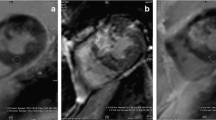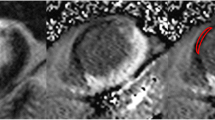Abstract
Gadobenate (Gd-BOPTA), injected at a dose of 0.1 mmol/kg body weight, was compared with gadopentetate (Gd-DTPA), injected at a dose of 0.2 mmol/kg body weight, for delineation of myocardial infarction interindividually in two groups of 26 patients each. Delayed enhancement images were assessed subjectively for image quality, and measured for regional T1 values before, 3 min after and 25 min after the injection of each contrast agent. In the 26 patients who received Gd-BOPTA, T1 values of remote myocardium were 1,070 ± 125 ms, 358 ± 78 ms and 562 ± 108 ms before, 3 min after and 25 min after injection, respectively. Infarcted myocardium values were 1,097 ± 148 ms, 246 ± 68 ms and 373 ± 84 ms and left ventricular blood pool 1,238 ± 95 ms, 194 ± 47 ms and 373 ± 72 ms. In the 26 patients who received Gd-DTPA, T1 values were 1,087 ± 96 ms, 325 ± 60 ms and 555 ± 108 ms for remote myocardium; 1,134 ± 109, 210 ± 43 ms and 304 ± 57 ms for infarcted myocardium; and 1,258 ± 104 ms, 166 ± 27 ms and 351 ± 73 ms for left ventricular blood pool. Delayed enhancement image quality showing myocardial infarction was rated good (54%) and excellent (46%) after Gd-BOPTA, and good (58%) and excellent (42%) after Gd-DTPA (no significant differences). A single dose of Gd-BOPTA compared with a double dose of Gd-DTPA causes similar changes of T1 values in infarcted and remote myocardium and provides fairly similar contrast between infarcted and remote myocardium (0.64 ± 14 versus 0.71 ± 11) and slightly higher contrast between left ventricular blood and infarcted myocardium (0.22 ± 17 versus 0.14 ± 6; p < 0.05). Administration of 0.1 mmol/kg body weight Gd-BOPTA can provide similar late enhancement images compared with the standard 0.2 mmol/kg body weight dose of Gd-DTPA due to the higher T1 relaxivity associated with the former.





Similar content being viewed by others
References
Kim RJ, Fieno DS, Parrish TB et al (1999) Relationship of MRI delayed contrast enhancement to irreversible injury, infarct age, and contractile function. Circulation 100:1992–2002
Choi KM, Kim RJ, Gubernikoff G, Vargas JD, Parker M, Judd RM (2001) Transmural extent of acute myocardial infarction predicts long-term improvement in contractile function. Circulation 104:1101–1107
Krombach GA, Niendorf T, Gunther RW, Mahnken AH (2007) Characterization of myocardial viability using MR and CT imaging. Eur Radiol 17(6):1433–1444
Schlosser T, Hunold P, Herborn CU, Lehmkuhl H, Lind A, Massing S, Barkhausen J (2005) Myocardial infarct: depiction with contrast-enhanced MR imaging—comparison of gadopentetate and gadobenate. Radiology 236(3):1041–1046
Cavagna FM, Maggioni F, Castelli PM et al (1997) Gadolinium chelates with weak binding to serum proteins. A new class of high-efficiency, general purpose contrast agents for magnetic resonance imaging. Invest Radiol 32(12):780–796
Pintaske J, Martirosian P, Graf H, Erb G, Lodemann KP, Claussen CD, Schick F (2006) Relaxivity of gadopentetate dimeglumine (Magnevist), gadobutrol (Gadovist), and gadobenate dimeglumine (MultiHance) in human blood plasma at 0.2, 1.5, and 3 Tesla. Invest Radiol 41(3):213–221
Sardanelli F, Quarenghi M (2006) Delayed enhancement of subendocardial infarcted myocardium with gadobenate dimeglumine: a paradoxical effect—is a double dose too much? Radiology 240(3):914–915
Balci NC, Inan N, Anik Y, Erturk MS, Ural D, Demirci A (2006) Low-dose gadobenate dimeglumine versus standard-dose gadopentate dimeglumine for delayed contrast-enhanced cardiac magnetic resonance imaging. Acad Radiol 13(7):833–839
Grundy SM, Pasternak R, Greenland P, Smith S Jr, Fuster V (1999) Assessment of cardiovascular risk by use of multiple-risk-factor assessment equations: a statement for healthcare professionals from the American Heart Association and the American College of Cardiology. Circulation 100(13):1481–1492
Grundy SM, Cleeman JI, Daniels SR et al (2005) Diagnosis and management of the metabolic syndrome: an American Heart Association/National Heart, Lung, and Blood Institute Scientific Statement. Circulation 112(17):2735–2752
Look D, Locker D (1970) Time saving measurement of NMR and EPR relaxation times. Rev Sci Instrum 41:250–251
Wagenseil JE, Johansson LO, Lorenz CH (1999) Characterization of t1 relaxation and blood-myocardial contrast enhancement of NC100150 injection in cardiac MRI. J Magn Reson Imaging 10(5):784–789
Flacke SJ, Fischer SE, Lorenz CH (2001) Measurement of the gadopentetate dimeglumine partition coefficient in human myocardium in vivo: normal distribution and elevation in acute and chronic infarction. Radiology 218(3):703–710
Simonetti OP, Kim RJ, Fieno DS et al (2001) An improved MR imaging technique for the visualization of myocardial infarction. Radiology 218(1):215–223
Saeed M, Wendland MF, Yu KK et al (1994) Identification of myocardial reperfusion with echo planar magnetic resonance imaging. Discrimination between occlusive and reperfused infarctions. Circulation 90(3):1492–1501
Wendland MF, Saeed M, Lauerma K, Derugin N, Mintorovitch J, Cavagna FM, Higgins CB (1997) Alterations in T1 of normal and reperfused infarcted myocardium after Gd-BOPTA versus GD-DTPA on inversion recovery EPI. Magn Reson Med 37(3):448–456
Holman ER, van Rossum AC, Doesburg T, van der Wall EE, de Roos A, Visser CA (1996) Assessment of acute myocardial infarction in man with magnetic resonance imaging and the use of a new paramagnetic contrast agent gadolinium-BOPTA. Magn Reson Imaging 14(1):21–29
Pruessmann KP, Weiger M, Scheidegger MB, Boesiger P (1999) SENSE: sensitivity encoding for fast MRI. Magn Reson Med 42(5):952–962
Firbank MJ, Coulthard A, Harrison RM, Williams ED (1999) A comparison of two methods for measuring the signal to noise ratio on MR images. Phys Med Biol 44(12):N261–N264
Dietrich O, Raya JG, Reeder SB, Reiser MF, Schoenberg SO (2007) Measurement of signal-to-noise ratios in MR images: influence of multichannel coils, parallel imaging, and reconstruction filters. J Magn Reson Imaging 26(2):375–385
Kellman P, Arai AE, McVeigh ER, Aletras AH (2002) Phase-sensitive inversion recovery for detecting myocardial infarction using gadolinium-delayed hyperenhancement. Magn Reson Med 47(2):372–383
Author information
Authors and Affiliations
Corresponding author
Additional information
Peter Lodemann is an employee of Bracco Deutschland GmbH.
Rights and permissions
About this article
Cite this article
Krombach, G.A., Hahnen, C., Lodemann, KP. et al. Gd-BOPTA for assessment of myocardial viability on MRI: changes of T1 value and their impact on delayed enhancement. Eur Radiol 19, 2136–2146 (2009). https://doi.org/10.1007/s00330-009-1400-z
Received:
Accepted:
Published:
Issue Date:
DOI: https://doi.org/10.1007/s00330-009-1400-z




